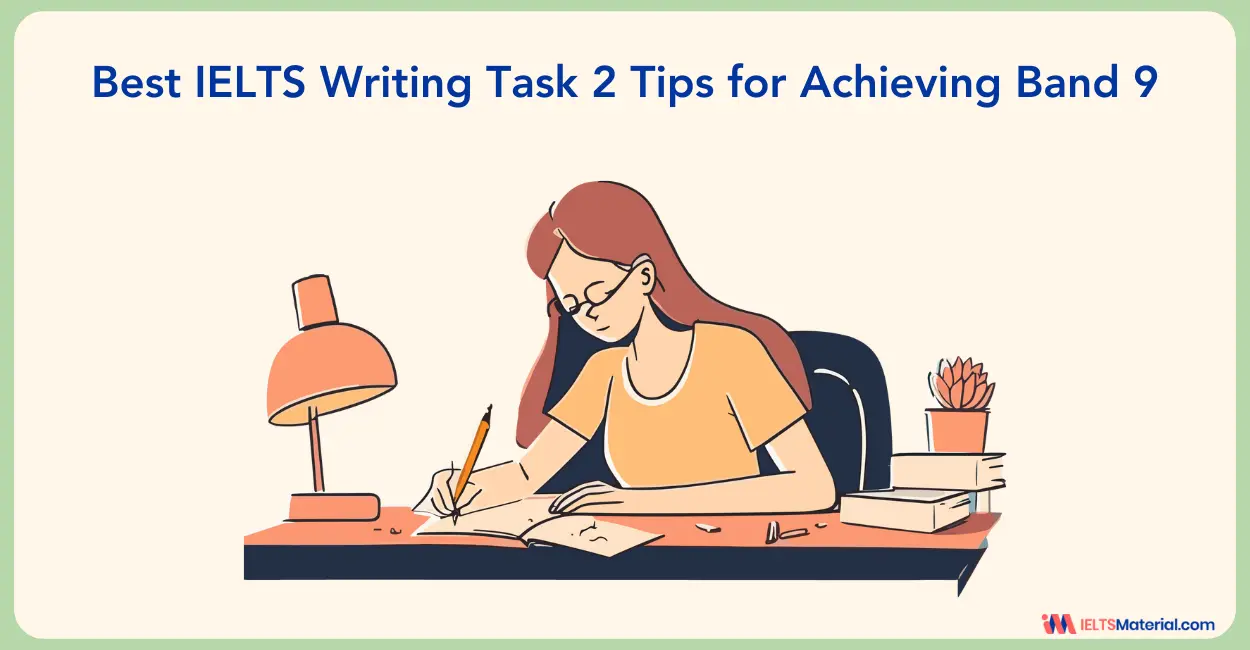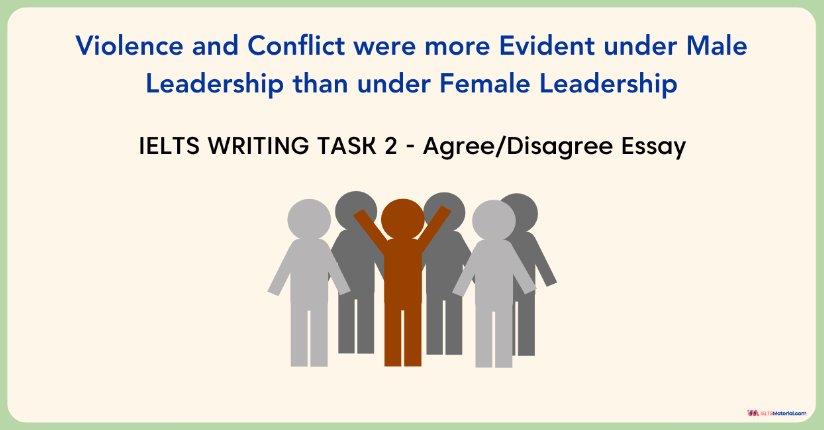Violence and Conflict were more Evident under Male Leadership than under Female Leadership - IELTS Writing Task 2
Need help answering “Violence and Conflict were more Evident under Male Leadership than under Female Leadership”? Here are Band 7–9 sample responses and expert vocabularies to master this IELTS Writing Task 2 topic.
Table of Contents
- Question
- Structure Breakdown
- Violence and Conflict were more Evident under Male Leadership than under Female Leadership - Sample Answer 1
- Violence and Conflict were more Evident under Male Leadership than under Female Leadership - Sample Answer 2
- Violence and Conflict were more Evident under Male Leadership than under Female Leadership - Sample Answer 3
- Violence and Conflict were more Evident under Male Leadership than under Female Leadership - IELTS Vocabulary
- Violence and Conflict were more Evident under Male Leadership than under Female Leadership - Connectors Used

Try AI Essay Checker for Instant Band Score
The essay prompt, “Violence and Conflict were more Evident under Male Leadership than under Female Leadership,” is an Agree/Disagree Essay task that has been featured in an IELTS test. The IELTS Agree-Disagree essay, also known as an IELTS Opinion Essay, asks test-takers to present a clear stance on a specific statement, where they should clearly state whether they agree or disagree with a given opinion.
The IELTS writing task 2 often challenges test takers with thought-provoking statements like: “Violence and Conflict were more Evident under Male Leadership than under Female Leadership.” This Agree/Disagree essay type requires a clear stance supported by strong arguments and relevant examples. To perform well, candidates must refine their writing skills and learn how to present balanced, well-structured opinions.
Learn how to write the perfect IELTS essay introduction for a Band 9 score with the guide below!
Question
You should spend about 40 minutes on this task.
World history suggests that violence and conflict were more evident under male leadership than under female leadership. So, for peace to prevail, female leadership can be considered as a better option than male leadership.
To what extent do you agree or disagree?
You should write at least 250 words.
Structure Breakdown
Essay Type
Introduction
Main Body Paragraph 1
Main Body Paragraph 2
Conclusion
|
Violence and Conflict were more Evident under Male Leadership than under Female Leadership - Sample Answer 1
While some argue that war and conflicts are impersonal irrespective of the gender of leaders, historical evidence suggests a correlation between female leadership and a reduction in violence. Throughout history, periods of female leadership have witnessed fewer instances of major wars, conflicts, and civil unrest compared to male-led eras.
On one hand, the majority of world wars, conflicts among nations, and civil wars have often been attributed to male-driven factors such as ego, assassinations, and conflicting interests. In contrast, the involvement of female leaders in decisions leading to war has been minimal. Even instances like the trojan war, often cited as an example of female influence, lack historical validation and are rooted more in mythology than concrete evidence. Additionally, even if such events were true, female leaders were not actively involved in initiating hostilities.
On the other hand, women by nature tend to be mild-hearted and averse to conflicts, making them less prone to engage in wars. Their caring and less aggressive traits position them as ideal leaders focused on serving the needs of the people. A leader with a compassionate mindset naturally excels in serving the interests of the nation, and women emerge as strong candidates in this aspect.
In summary, the concept of female leadership, with its potential to deter wars and enhance service to nations, holds merit and deserves consideration for a better world.
Violence and Conflict were more Evident under Male Leadership than under Female Leadership - Sample Answer 2
Throughout human history, violence and conflict have been pervasive, marking the course of our existence from the very beginning. A glance at our past or the contemporary world reveals a landscape dotted with wars, power struggles, revolutions, and rulers ranging from peace-makers to ruthless tyrants. The historical backdrop also underscores the predominantly male-dominated nature of society, with men occupying leadership roles. While it may be tempting to attribute atrocities solely to male rulers, a closer examination reveals that the inclination towards conflict is a universal human trait.
While, many notable women in history, such as Queen Isabella of Spain, Queen Mary (Bloody Mary), and Victoria and Elizabeth of Britain, wielded considerable power and often exhibited ruthlessness in pursuit of their goals. They engaged in wars that can be compared to those orchestrated by men. These women, far from being historical anomalies, exemplify a broader trend of individuals transcending gender boundaries in their pursuit and consolidation of power, while concurrently advancing peace when deemed feasible.
Conversely, examining the two major wars of modern history, World Wars I and II, underscores the impersonal nature of conflicts. Wars, driven by a universal human thirst for power, transcend factors such as race, religion, nationality, and gender. While men held leadership positions during these global conflicts, it would be simplistic to assume that female leaders, like Margaret Thatcher, known as the Iron Lady for her resolute actions in the Falklands War, would inherently be more diplomatically peaceful than their male counterparts, such as Winston Churchill and Franklin D. Roosevelt, who navigated the challenges posed by Hitler’s Axis.
In the crux, we can say that the gender issue primarily manifests itself in the battle of the sexes, not in the broader conflicts among nations and peoples. Therefore, it is inappropriate, if not irrational, to conclude that world conflicts arise from the rule of a particular gender and that the so-called “finer sex” would inherently excel at preserving peace if selectively placed at the helm of human nations.
Struggling to Crack the IELTS opinion essays? Our 8+ band trainers have got you! Sign up for a FREE demo now!
Violence and Conflict were more Evident under Male Leadership than under Female Leadership - Sample Answer 3
Upon delving into major historical archives, a notable observation emerges: many wars and conflicts transpired under male leadership. Some analysts advocate for favoring female leadership as a potential means to maintain peace and harmony, viewing it as a countermeasure to the historical trend. However, this approach, suggesting leadership based on gender as a direct path to peace, appears flawed and oversimplified.
While it is, proponents of female leadership often point to historical conflicts under male leaders like Adolf Hitler or Benito Mussolini. However, it is equally valid to argue that atrocities occurred under female leaders, such as Queen Elizabeth during the Iron Age. Additionally, attributing innate nurturing and non-aggressive characteristics to women while labeling men as inherently aggressive oversimplifies the complexities of human behavior.
In a balanced assessment, it is more sensible to elect leaders based on democratic principles and their qualifications. Citizens ideally possess the right to vote for a leader freely, and leadership qualifications, encompassing experience, favorable qualities, and innate moral values, should play a pivotal role in the selection process. It is essential to acknowledge the evolving role of gender, recognizing that historical trends may have been influenced by fewer opportunities for women in leadership roles.
In conclusion, the notion that peace would inherently prevail under female leaders is overly simplistic. The paramount consideration should be the selection of the most qualified person, irrespective of gender, chosen by citizens exercising their free will in a democratic process.
Ready to grab the latest IELTS writing task 2 question papers of 2025? Buy now!
Violence and Conflict were more Evident under Male Leadership than under Female Leadership - IELTS Vocabulary
Have a look at the IELTS Vocabulary used in the sample answers for ‘Violence and Conflict were more Evident under Male Leadership than under Female Leadership - IELTS Writing Task 2’.
Instances
- Meaning: an example or single occurrence of something.
- Example: This is a serious instance where all the leaders were portrayed in a bad way.
Conflicts
- Meaning: A serious disagreement or argument.
- Example: The eternal conflict between the genders.
Assassination
- Meaning: the action of assassinating someone.
- Example: Gandhi’s assassination is still a very revolting topic of discussion.
Minimal
- Meaning: Of minimum amount; quantity; or degree.
- Example: The aircraft suffered minimal damage.
Validation
- Meaning: the action of declaring something officially acceptable.
- Example: This technique requires validation of the respective leaders.
Averse
- Meaning: Having a strong dislike of or opposition to something.
- Example: She is not averse to taking chances.
Pervasive
- Meaning: spreading widely throughout an area or a group of people.
- Example: Playing video games is pervasive among kids.
Anomalies
- Meaning: something that deviates from what is standard, normal or expected.
- Example: There are various anomalies in the present system.
Helm
- Meaning: in charge of an organization.
- Example: She was at the helm of the government’s office.
Delving
- Meaning: reach inside a receptacle and search for something.
- Example: She delved in her pocket to find for her napkin.
Nuanced
- Meaning: a very slight difference
- Example: Their opinions are always nuanced and informing.
Innate
- Meaning: inborn; natural
- Example: She had an innate capacity for organization.
Curious about your IELTS Writing score? Submit your IELTS Writing Essay for evaluation & get improvement tips!
Violence and Conflict were more Evident under Male Leadership than under Female Leadership - Connectors Used
Connectors, also known as connectives or transition words, are words or phrases that link ideas or parts of a sentence or paragraph together. Here are some of the connectors used in the above sample answers:
- On one hand,
- On the other hand,
- In summary,
- While,
- Conversely,
- In the crux,
- While it is,
- In a balanced assessment,
- In conclusion,
Boost your IELTS Writing Task 2 score and learn how to write standout essays. Sign up for an expert session today!
Mastering the Agree/Disagree essay in IELTS Writing Task 2 requires clarity, critical thinking, and a well-organized response. By analyzing sample answers and understanding how to present a strong viewpoint, you can enhance your writing skills and aim for your desired IELTS Band Score. Remember to proofread your essay for grammar, vocabulary, and spelling errors. These tips, combined with practice, will help you write well-structured and coherent IELTS Writing Task 2 Opinion Essay like the ‘Violence and Conflict were more Evident under Male Leadership than under Female Leadership.’
Useful Links:
- How to Plan an IELTS Opinion Essay?
- Recent IELTS Topics in Writing Task 2 for 2025
- Best IELTS Writing Task 2 Tips for Achieving Band 9
- Tips to Write an Effective Introduction for IELTS Writing Task 2
- IELTS Writing Answer sheet
- Popular Synonyms for 'My Opinion' You Can Use in IELTS
- IELTS Writing Task 2: Should I give my opinion?
- Parallelism in IELTS Writing: What It Is and How to Use it?
Practice IELTS Writing Task 2 based on Essay types

Start Preparing for IELTS: Get Your 10-Day Study Plan Today!
Recent Articles

Haniya Yashfeen


Prity Mallick

Kasturika Samanta




Post your Comments